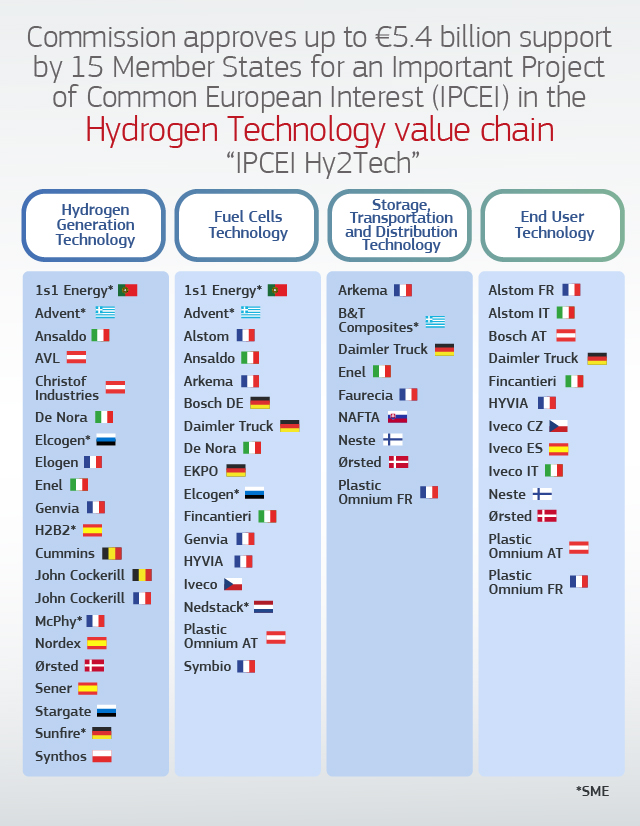European Commission approves up to €5.4 billion of public support by fifteen Member States for an Important Project of Common European Interest in the hydrogen technology value chain
The Commission has approved, under EU State aid rules, an Important Project of Common European Interest (‘IPCEI’) to support research and innovation and first industrial deployment in the hydrogen technology value chain. The project, called “IPCEI Hy2Tech” was jointly prepared and notified by fifteen Member States: Austria, Belgium, Czechia, Denmark, Estonia, Finland, France, Germany, Greece, Italy, Netherlands, Poland, Portugal, Slovakia and Spain.
The Member States will provide up to €5.4 billion in public funding, which is expected to unlock additional €8.8 billion in private investments. As part of this IPCEI, 35 companies with activities in one or more Member States, including small and medium-sized enterprises (‘SMEs’) and start-ups, will participate in 41 projects.
Executive Vice-President Margrethe Vestager, in charge of competition policy, said: “Hydrogen has a huge potential going forward. It is an indispensable component for the diversification of energy sources and the green transition. Investing in such innovative technologies can however be risky for one Member State or one company alone. This is where State aid rules for IPCEI have a role to play. Today’s project is an example of truly ambitious European cooperation for a key common objective. It also shows how competition policy works hand in hand with breakthrough innovation.”
Commissioner for the internal market, Thierry Breton said: “Promoting hydrogen development and deployment will boost jobs and growth throughout Europe while contributing to our green and resilience agenda. It enables the clean transition of energy-intensive industries and increases our independence from fossil fuels. With this IPCEI, we see EU hydrogen production moving “from lab to fab”; and our industry turning technological mastery into commercial leadership. And of course, we are not only supporting hydrogen through funding. We have also made decisive progress on building partnerships through the Clean Hydrogen Alliance and are developing EU-wide rules for enabling the hydrogen market and creating dedicated infrastructure. Because we know what is at stake: Europe’s position as a leading region for the hydrogen industrial transformation.”
The IPCEI will cover a wide part of the hydrogen technology value chain, including (i) the generation of hydrogen, (ii) fuel cells, (iii) storage, transportation and distribution of hydrogen, and (iv) end-users applications, in particular in the mobility sector. It is expected to contribute to the development of important technological breakthroughs, including new highly efficient electrode materials, more performant fuel cells, innovative transport technologies, among which first time roll out hydrogen mobility ones. The IPCEI is expected to create approximately 20.000 direct jobs.
Commission assessment
The Commission assessed the proposed project under EU State aid rules, more specifically its Communication on Important Projects of Common European Interest.
Where private initiatives supporting breakthrough innovation fail to materialise because of the significant risks such projects entail, IPCEI enable Member States to jointly fill the gap to overcome these market failures. At the same time, they ensure that the EU economy at large benefits from the investments and limit potential distortions to competition.
The Commission has found that the IPCEI Hy2Tech fulfils the required conditions set out in its Communication. In particular, the Commission concluded that:
- The project contributes to a common objective by supporting a key strategic value chain for the future of Europe, as well as the objectives of key EU policy initiatives such as the Green Deal, the EU Hydrogen Strategy and REPowerEU.
- All 41 projects part on the IPCEI are highly ambitious, as they aim at developing technologies and processes that go beyond what the market currently offers and will allow major improvements in performance, safety, environmental impact as well as on cost efficiencies.
- The IPCEI also involves significant technological and financial risks, and public support is therefore necessary to provide incentives to companies to carry out the investment.
- Aid to individual companies is limited to what is necessary, proportionate and does not unduly distort competition. In particular, the Commission has verified that the total planned maximum aid amounts are in line with the eligible costs of the projects and their funding gaps. Furthermore, if large projects covered by the IPCEI turn out to be very successful, generating extra net revenues, the companies will return part of the aid received to the respective Member State (claw-back mechanism).
- The results of the project will be widely shared by participating companies benefitting from the public support with the European scientific community and industry beyond the companies and countries that are part of the ICPEI. As a result, positive spill-over effects will be generated throughout Europe.
On this basis, the Commission concluded that the project is in line with EU State aid rules.
Funding, beneficiaries and amounts
The IPCEI will involve 41 projects from 35 companies, including 8 small and medium-sized enterprises (‘SMEs’) and start-ups, with activities in one or more Member States. The direct participants will closely cooperate with each other through numerous planned collaborations, and with over 300 external partners, such as universities, research organisations and SMEs across Europe.
The timelines of this IPCEI vary in function of the individual projects and the companies involved.
The direct participants, the Member States supporting them and the different technology fields are as follows:

More information on the amount of aid to individual participants will be available in the public version of the Commission’s decision once the Commission has agreed with Member States and third parties on any confidential business secrets that need to be removed.

